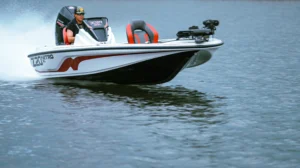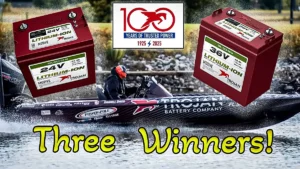Though I’m a dedicated bass fisherman, I occasionally enjoy taking a break to chase after big striped bass. Striper fishing is a fantastic way to catch a lot of large fish and have a great time. I’ve fished for stripers from eastern Tennessee to southern Alabama, and it’s always an exhilarating experience, regardless of where you are.
The advent of live sonar has revolutionized our approach to fishing, particularly for offshore stripers. This technology has significantly improved our effectiveness and efficiency on the water. Once you grasp how stripers appear on live sonar, where to locate them, and what lures to use, targeting this species becomes straightforward and highly productive.
IDENTIFYING STRIPER ON LIVE SONAR
The easiest way to identify differing species of fish using live sonar is by recognizing their size and how they act.
Size is the most identifiable sign of what type of fish you are looking at. Obviously striper are much larger than the typical largemouth bass, sometimes reaching sizes up to 60-plus pounds. These fish will have a much larger return on live sonar due to their overwhelming size. This makes spotting and tracking these fish much easier than the typical bass. This is a really great way to practice targeting individual fish on live sonar.
The next important thing when trying to identify these fish is knowing how they act. Striper often run in groups, so once you locate one you’ll often find a big group of them close by. These fish tend to suspend high in the water column. While some striper do hang out on the bottom, I’ve found that these suspending fish are often much easier to coax into biting when using artificial lures and live sonar.
These fish tend to be far more aggressive than a typical bass, making them an absolute blast to catch. Some of the most aggressive strikes come from when you locate a tight group of striper on live sonar. The competition of other fish causes them to fight over the lure, leading to some ferocious bites. Targeting individual fish can be a great tactic as well, however these fish can sometimes be a little more stubborn when using artificial lures. While it is important to understand what these fish look like on live sonar, understanding where they are is equally crucial to a successful day of striper fishing.
HOW TO LOCATE STRIPER
There are a few things that striper seem to relate to on nearly every fishery I’ve ever targeted them on. These fish predominantly reside offshore, excluding a short period of time where they can be caught shallow. I’ve caught these fish on a mix of differing structures and types of cover. However, some of my most consistently productive areas include fishing around birds and standing timber.
Fishing around birds is one of my absolute favorite ways to catch striped bass. I’ve used this technique to catch striper on a number of different lakes. However Lake Cherokee in Jefferson City Tennessee is by far the most productive lake I’ve ever experienced for catching striper around birds. The best way to do this technique is by simply driving around the lake and looking for groups of birds. These birds don’t always have to be diving on bait, I’ve had success fishing around large groups of birds just sitting on the top of the water as well.
Once you locate a group of birds, come off pad and drop your trolling motor at least 100-feet away. This gives you enough space to approach the group of fish without spooking them. I will then implement my live sonar and cast at individual or groups of fish suspending under these birds. These birds follow the bait, which is the main reason the striper are so drawn to them.
Fishing around birds is often where you can find some of the biggest groups of striper in the lake. When fishing on Lake Cherokee, I would see hundreds if not thousands of striper suspending beneath these birds feeding on bait. Sometimes so many that they would fill my entire sonar screen no matter what direction I pointed my trolling motor. This is a great way to catch a ton of fish in a short amount of time.
Another super productive way to target striper is by looking for standing timber. Standing timber is a great for holding tons of baitfish and other types of forage striper love to feed on. This can be an overwhelming type of cover to fish on certain lakes due to the sheer amount of timber present on these bodies of water. Locating specific areas of the timber these fish are holding on is crucial for finding active striper.
During the summer, I like to start off by targeting main lake humps with flooded timber. Striper will often suspend right above the flooded timber making them easy to spot using your live sonar. You can fish timber in nearly any depth, however I’ve had the most success when the timber comes upon to around 20 feet beneath the surface. This seems to be the sweet spot for locating actively feeding striper on my local bodies of water.
LURE SELECTION
You can catch these striper on a multitude of different baits, however a few lures Ive had a lot of success with include a swimbait, an Alabama Rig and a topwater spook.
A small swimbait has been one of my most productive lures for catching striped bass all year long. Throwing this bait at individual or large groups of fish is a great way to get them to react. You can catch any size of fish on this bait and it is great for getting a ton of bites. Once you locate a fish, throw your swimbait 10 or 15-feet past them and allow it to sink down to their depth. I like to then slowly reel it back to the boat making sure to go right over their head. Once the fish notices my swimbait and starts to approach, I will speed up my retrieve giving them the allusion of a fleeing baitfish. My go-to swimbait for this application is a 3.3 inch Keitech Swing Impact Fat (buy at Tacklewarehouse) on a 1/4 to 1/2-ounce Berkley Fusion 19 Swimbait head depending on the depth.
Another lure I love to throw at suspended striper is an Alabama-Rig. This is the perfect lure for practicing your live sonar skills. It can be difficult to track a small swimbait on live sonar. However an Alabama-Rig has a huge profile causing it to really pop on live sonar. This is how I first started getting comfortable using my electronics to target individual fish. I fish this bait very similar to a swimbait, throwing it out over the fish and reeling it right past their face at a fast speed. I’ve had numerous instances on the bait where I have caught multiple fish on one cast, which is always a blast.
I use two different Alabama rigs for this type of fishing. One of my personal favorites is the Stealth Lures “Stealth Rig” made by Saxton Long. This Stealth Rig is made out of a clear bendable material which is extremely durable. This clear profile also gives fish a look they aren’t used to seeing with the typical Alabama rig. This bait will be widely available for purchase this coming fall. Another great choice is the 6th Sense Divine. This bait is much heavier than the Stealth rig and is still extremely durable. Both are great options for targeting big, trophy class striper.
Lastly, one of my favorite lures to target striped bass with is a topwater Spook style walking bait. This bait really shines during the summer, especially when you can find groups of striper blowing up on shad. Throwing this bait in the mix of striper feeding on top of the water is a sure fire way to get some awesome bites this time of year.
You can also target these fish with a walker using live sonar. I like to look for groups of fish 15 feet or less under the surface of the water depending on water clarity. I will then make a long cast over the fish and quickly work the walker back to the boat. Once the striper notice the bait, you can watch them rocket from the depths to destroy it on your live sonar. My go-to walking topwater for this application is the Reaction Innovations Vixen.
Catching striper can be an absolute blast and a great way to practice getting proficient using live sonar. This a great way to get someone into fishing who just wants to go out and catch a bunch of fish. These baits and techniques will catch striper on any lake or body of water you fish that has stripers present.















